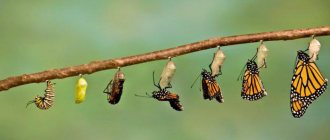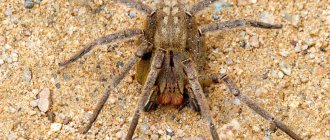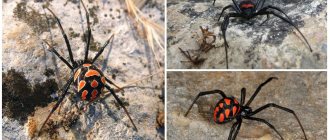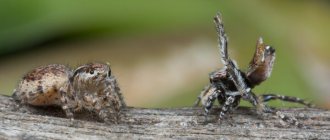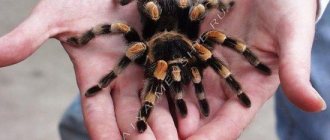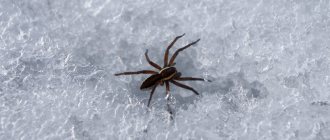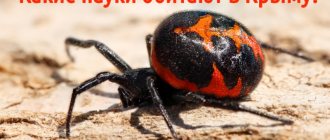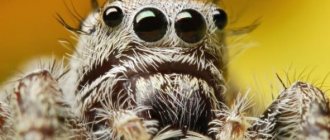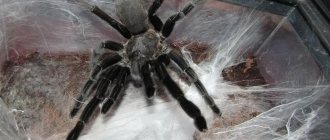Where do spiders go in winter?
Arthropods adapt to the onset of cold weather in different ways. Spiders are unable to tolerate temperatures below 0 degrees due to tissue crystallization. Depending on this, spiders can sleep or die in winter.
Young cross spiders and “newborn” wasp spiders migrate on wind-blown spider webs in search of habitat on warm September days. Huddled in a crack in the bark of a tree, spiders sleep in winter.
Sexually mature parents of baby wasps end their life in the summer: the male - in the form of a “wife” dinner after mating, the female - after laying eggs. A similar situation occurs in adult crosses. Autumn is the mating season, when males go in search of females sitting in their web. After fertilization of the female, the male dies. The spider weaves a cocoon in which it lays eggs. Having hidden it in a secluded place (in the bark of trees, cracks in masonry), it also dies. In the spring, spiderlings emerge from the eggs, ready to weave webs.
Males and females of black widows do not survive until the cold weather. At the end of June, mating occurs, after which the female eats the “suitor”. Having laid up to 130 eggs in prepared cocoons, she hides them in lairs (mouse holes, crevices) entwined with dense cobwebs and dies. Spiders appear in September and live in a cocoon until April, eating each other. With the onset of stable heat, they go outside.
As for the species of black widows, spiders that were born in September spend the winter with them. In a warm cocoon left by a caring spider mother, they sleep until April. Spreading in search of habitats, they have arachnoid and venom-carrying apparatus. During mating at the end of June, the female karakurt eats the male. After laying eggs it dies.
Domestic arthropods may go into torpor with the onset of winter if the number of indoor parasites decreases sharply. Waking up before the onset of spring, they can feed on their relatives.
Rare species live in burrows and crevices
Predatory arthropods, whose life cycle exceeds a year, fall into torpor with the onset of cold weather. Species such as tarantulas live in the wild for 5 to 10 years. Helping them survive is the ability to go without food for a long time and the mild climate in their habitats. With the onset of cold weather, they burrow into their vertical burrows and hibernate until spring.
The edge hunter has a life expectancy of 2 years, until the age of mating. After breeding, they die in August. Immature individuals spend two winters in the mother's cocoon, attached to the grass on the shore, in a state of torpor.
Silverback spiders build their winter cocoons underwater
During the cold season, when rivers and lakes are frozen, the silverfish prepares winter housing. The spider controls the volume of the bell and the oxygen content in it. The air supply in such a cocoon is enough for 4-5 months. Nearby, the silverfish weaves the second and third mesh networks and fills them with air. This insurance allows you to overwinter without rising to the surface until warm days arrive.
Hiding in a mollusk shell
If there is no algae and nowhere to go, the water spider can use an abandoned mollusk shell instead of a cocoon. He fills it with air bubbles from the surface and covers it with thick nets instead of curtains. Such a house serves as reliable protection from large fish and crayfish.
They overwinter with young offspring (the female is eaten in the spring)
The black fathead spends its winter in a special way. With the onset of autumn, the mating period approaches, and the males go in search of females. Having carried out the necessary fertilization ritual, the male remains to live in the same burrow with the female. The fathead spider makes a cocoon for its offspring, where it soon lays eggs.
For 2 months, spiders guard the clutch in a cocoon. With the onset of spring, spiders appear. Spiders serve as food for them. By the end of summer there are 3 molts. Young spiders crawl out of their holes to find a home. After 2 moults they will become sexually mature and will look for a female. A male spider, whose life cycle is less than a year, dies by this time.
Spiders in the house: is it dangerous?
Some people experience fear and discomfort if spiders appear, because... they don’t know for sure whether they bite or are dangerous to humans. In fact, most species of arthropods that settle in human homes are characterized by low aggressiveness, therefore, when a person approaches, they try to hide in a safe place. In addition, most arthropods living in houses and apartments are non-poisonous, i.e. the enzymes they produce in small quantities, when injected during a bite, cannot harm the human body.
If there are a lot of spiders in the house, whether this is good or bad is difficult to figure out. Arthropods living in apartments are predators, i.e. they hunt other insects. Thus, the benefits of spiders are great, because... they can destroy flies, bedbugs, moths and other pests. In addition, you don’t have to worry that the number of these arthropods will grow rapidly. How long these creatures live depends on the abundance of food and the species of these creatures. Their numbers are regulated by slow reproduction and low survival rate of young animals.
Reasons for appearance
To understand where spiders come from in an apartment, you need to assess the condition of the home. Arthropods can enter a room in the following ways:
- through open windows and doors;
- on outerwear;
- with garden tools;
- on flowers;
- from the attic;
- via sewer lines from the basement.
At the same time, it must be taken into account that in rooms where general cleaning is regularly carried out, these creatures are extremely rare.
To understand why there are a lot of spiders at home, you need to figure out what these creatures feed on in the apartment. Most of them are predators, so if there are too few insects in the room for them to feed on, the number of these creatures will be insignificant.
In addition, the reason why there are many spiders in the apartment may lie in favorable weather conditions. Human homes have a more stable microclimate than outside. The lack of wind helps the web last longer, so these creatures can expend less energy to produce it.
Scorpios
Centipedes are followed by the second link in the chain called “Who Eats Who in the Desert.” Scorpions often become killers of small arthropods, so they rightfully occupy third place on the list. They are found only in hot countries, however, science knows of 1,750 different species. Only fifty of them are poisonous to humans. Their unique feature is recognized by their long history: they are the most ancient of terrestrial arthropods. By studying scorpions, you can learn a lot about the evolution of animals, trace their development path from a marine lifestyle to a land one. Like centipedes, these desert animals, whose names are known to everyone, are nocturnal, hiding in rock crevices during sunny hours. Fast running and strong claws help them kill insects and arachnids.
What do spiders eat in the apartment?
Many people like to breed various exotic creatures in their apartments, which include house spiders. They belong to the species Tegenaria Domestica.
And in order for them to feel comfortable and develop normally, it is important to first consider the main features of the content.
When studying what domestic spiders eat in an apartment, it is worth noting that their diet is practically no different from the menu of their wild relatives. The owners often feed them with insects, scale insects, snails, caterpillars, small vertebrates, reptiles, and amphibians. But large animals are fed with small rodents.
House spiders that enter through windows, doors, and cracks eat the following insects:
- cockroaches;
- mole;
- moth caterpillars;
- midges;
- mosquitoes;
- fruit flies;
- butterflies;
- os;
- bees
Often many arachnids are found in apartments with complete unsanitary conditions and the presence of many pests. Small spiders eat all living creatures that may live in the apartment.
Nutrition depends on the size of the insect. For example, small predators are able to eat fruit flies, caterpillars, and mosquitoes.
Medium-sized inhabitants can only feed on insects - they catch flies, bees, and wasps. If a large victim gets caught in the web, the spider unravels it and releases it. He does the same with bedbugs, because they emit an unpleasant odor.
Diet in the natural environment
Spiders are classified as obligate predators, whose menu includes exclusively small vertebrates and insects . Arachnologists mention the only exception - Bagheera kiplingi, a jumping spider living in Central America.
Upon closer examination, Kipling's Bagheera is not 100% vegetarian: during the dry season, this spider (for lack of Vachellia acacia foliage and nectar) devours its relatives. In general, the ratio of plant and animal food in the diet of Bagheera kiplingi looks like 90% to 10%.
Hunting methods
They depend on the lifestyle, sedentary or nomadic. A wandering spider usually lies in wait for its victim or carefully creeps up to it, overtaking it with one or two or three jumps. Nomadic spiders prefer to envelop prey with their threads.
Sedentary spiders do not run after the victim, but wait until it wanders into a skillfully woven net. These can be either simple signal threads or sophisticated (large in area) networks stretched to the observation post of their owner.
This is interesting! Not all hunters entangle their victims with webs: some (for example, Tegenaria Domestica) simply wait for the insect’s body to soften to the desired condition. Sometimes the spider releases its prey. This happens in two cases: if it is too large or has a strong smell (bug).
The spider kills prey with a toxin concentrated in poisonous glands, which are located in the chelicerae or (as in Araneomorphae) in the cephalothorax cavity.
The spiral muscles surrounding the glands contract at the right moment, and the poison reaches its destination through a hole at the tip of the claw-like jaws. Small insects die almost immediately, while larger ones continue to convulse for some time.
Hunting objects
For the most part, these are insects of suitable size. Spiders that weave nets more often catch all flying creatures, especially dipterans.
The species “assortment” of living creatures is determined by habitat and season. Spiders that live in burrows and on the soil surface eat mainly beetles and orthoptera, not disdaining, however, snails and earthworms. Spiders from the family Mimetidae target spiders of other species and ants.
Argyroneta, a water spider, specializes in aquatic insect larvae, fish fry and crustaceans. Spiders from the genus Dolomedes, which inhabit wet meadows and swamps, eat approximately the same thing (small fish, larvae and tadpoles).
The most interesting “dishes” are included in the menu of tarantula spiders:
- small birds;
- small rodents;
- arachnids;
- insects;
- fish;
- amphibians.
Young snakes often appear on the table of the Brazilian tarantula Grammostola, which the spider devours in huge quantities.
Nutrition method
It has been proven that all arthropods demonstrate an arachnid (extraintestinal) type of nutrition. The spider has everything adapted for consuming liquid food, from the filtering device of the pre-oral cavity and pharynx, the narrowed esophagus and ending with a powerful sucking stomach.
Important! Having killed the victim, the spider tears and crushes it with its jaws, releasing digestive juice inside, designed to dissolve the insides of the insect.
At the same time, the spider sucks up the protruding liquid, alternating between eating and injecting juice. The spider does not forget to turn the corpse over, processing it from all sides until it turns into a dried mummy.
Spiders that attack insects with hard cover (for example, beetles) pierce their articular membrane with chelicerae, usually between the chest and head. Digestive juice is injected into this wound, and the softened contents are sucked out from there.
Who eats spiders
There are plenty of people who like to eat spiders; these arthropods have plenty of enemies. Even among people there are true admirers of this delicacy who regard spiders as delicious food.
In Cambodia, for example, fried tarantulas are a popular food. Live spiders are drowned in rice wine to create a natural product with medicinal properties.
In Scone, spiders are a popular tourist commodity. Birds, insects, wasps, rodents, amphibians, and reptiles also love spider meat. But the number of these arthropods is also declining thanks to their brothers: spiders are not averse to feasting on each other.
Important! The main enemy of spiders is humans, because as a result of their agricultural activities with the use of insecticides, entire colonies of spiders and other insects are destroyed.
Birds
Birds are the most diverse and numerous enemies of spiders among representatives of the animal world. There is probably no bird that voluntarily turned itself away from the opportunity to eat a spider. Sparrows, tits, thrushes, crows, flycatchers, woodpeckers, starlings, rooks, swallows, warblers, wagtails, owls and many other species get spiders for food from any place, including from their own webs.
The nectar spider trap exclusively recognizes these arthropods for food.
Tits, according to scientists, prefer spiders due to the significant content of taurine in them, which is an amino acid that can influence the development of the entire animal’s body, have a beneficial effect on intellectual capabilities, reduce the feeling of anxiety, and improve visual capabilities.
Did you know? Even cats eat spiders as an exotic and uncharacteristic delicacy.
Spiders, in the form of food, enrich small tit chicks with all the necessary substances that help them grow and leave their parental nest as brave and smart adult birds.
The bustard eats karakurts, filling their stomachs completely with them.
Other spiders
Spiders are real enemies of their own brothers. In nature, they are true cannibals. Larger species of spiders hunt and eat smaller ones, but this happens only when necessary. After mating, females can get enough of a recent partner in order to obtain the necessary amount of protein food for their future cubs.
Did you know? Once common in South America, tarantulas are rarely seen as catching them and selling them as pets has become a real business.
The greatest threat to other spiders is the long-legged spider that lives in people's houses and apartments. By spring, he remains the only arthropod inhabitant in the house, since during the winter he is able to eat other brothers, sometimes not disdaining even his own children.
Mirhetidae recognizes only its fellows. These killers, sharply attacking a relative in the leg, calmly watch his death from a convenient hiding place, and then suck him out completely.
Insects
Many insects hunt for spiders as food - ants, scolopendras, scolopendras. Praying mantises eat any insects, spiders and do not disdain even their relatives. Hymenoptera predators, as well as flies, also love to feast on arthropods.
Cyrtidae flies also lay eggs, which produce active larvae ready to search for spiders. They penetrate the abdominal part of the arachnid, parasitize there, and even the larva’s breathing is carried out due to its adherence to the trachea of the arthropod. And they overwinter just like that, and pupate in the spring.
The mole cricket is the tarantula's worst enemy, attacking them barely alive with the arrival of spring, finishing them off and eating them. In the summer, when tarantulas grow stronger and their poisonous properties are restored, the mole cricket most often suffers defeat. Ectoparasite mites Gamasoidae and Trombidiidae can live on spiders.
Did you know? More than 40 thousand different species of spiders are known.
Wasps
Wasps are also serious enemies of some arthropod species. Calymmochilus dispar and Gelis apterus, two species of wasps discovered in Portugal in 2013, capture their prey by paralyzing with poison, lay eggs in it, and the larvae that hatch later reinforce their strength with the insides of a paralyzed but living spider and emerge into the wild.
Such species of wasps as Pompilidae and some Sphecidae paralyze the central nervous system of the victim from the order of arachnids with a stinging prick, move it to a convenient place, and lay their eggs on the spider. When the larvae emerge, they eat the living tissues of the victim until they pupate. Pompidae wasps open the lid of a complex burrow and bravely enter the lair of the Ctenizidae spider, quickly cutting off all escape routes for the victim.
Important! Some species of spiders are listed in the Red Book because they are currently on the verge of extinction from the face of the Earth.
Rodents
Mice, rats, dormice, mole rats, mole rats and other types of rodents also happily feed on arachnids when possible.
In the expanses of Central Asia, the dormouse, which belongs to the mammals of the order of rodents and the only species of the Selevinia genus, is engaged in the extermination of tarantulas.
Did you know? Often spiders lose some of their limbs, which are able to recover after molting, but are already slightly shorter than before. Literally seconds after the end of the molting process, this lack of legs becomes almost invisible.
Amphibians and reptiles
There are many species of lizards, snakes, frogs, toads and other amphibians and reptiles that feed on spiders. Frogs and toads at a young age, thanks to the meat of arachnids, mature and gain strength. Adult representatives of these animals also continue to eat spiders throughout their lives.
Lizards and snakes, eating arachnids, not only replenish their energy reserves with the help of their favorite delicacy, but also help control the arthropod population.
In nature, everything is harmonious, there is no one or anything superfluous. And if spiders exist on earth, then this must be so to maintain natural balance. Therefore, people should reconsider their thoughtless extermination of these animals and begin to treat them with greater understanding, then gradually some species of arachnids will leave the pages of the Red Book.
Was this article helpful?
Yes
No
Wasps
Several species of wasps view them as prey, including Calymmochilus dispar and Gelis apterus. These two species were discovered in Portugal in 2013. These wasps are parasitic, laying eggs inside insects that remain alive but paralyzed. When young offspring are born, they immediately have access to fresh food, which will provide them with the necessary amount of calories for further growth.
What types of spiders are there?
Spiders, represented by several species, live in the house with humans. Most often it is:
- haymaker (also known as centipede or windowcutter);
- black or gray;
- tramp.
The harvester has a body with a round or oval abdomen, six or eight legs, which are its distinctive feature. The length of the window spider's legs reaches 5 cm. The centipede weaves complex, extensive webs that trap small insects. The spider guards the victim who falls into the web, and as soon as the active desire to escape makes her so entangled that she cannot move, she injects paralyzing poison into her.
In a house or apartment, the haymaker chooses places near windows or in dark corners, hanging mostly upside down. When large insects approach, the spider, guarding the web, tries to swing it as actively as possible.
Black or gray house spiders are noticeably smaller than harvest spiders. Their body length does not exceed 14 mm. The web of such spiders resembles a pipe in shape, which after each victim the arthropod returns to its original position, repairing damage. Most often, female gray and black spiders hunt for small insects in the house.
An interesting type of domestic arthropod is the vagrant. They can be distinguished by their elongated body and long legs. The main feature of spiders is the absence of webs. They don't need it for hunting. Vagrants attack their prey while jumping, instantly paralyze it with poison, and then actively eat it. Predators do not stay in one house for long.
For humans, the poison of tramps is not dangerous, given the characteristics of our climate. In countries with hot climates, spider venom can cause inflammation of the skin.
In addition to the arthropods listed above, other species may appear in the house, but this does not happen so often.
Lizards
Perhaps when hot and arid regions are mentioned, these desert animals are the first to come to mind. Photos of lizards on the sand are one of the most popular associations with these regions. It is not surprising, because this is the largest group of reptiles. Real lizards are always quite small, up to forty centimeters in length. Desert species are distinguished by a special structure of their paws with long toes equipped with lateral teeth - it is because of them that the animal does not fall into the sand. Another interesting feature is autotomy, or the ability to shed its tail. He continues to move, diverting attention to himself and giving the lizard enough time to escape from the enemy. Fast and agile creatures rightfully occupy fourth place in the list showing who eats whom in the desert, coping with insects, arthropods, and even scorpions.
What do they eat in winter?
Most spiders cannot eat their food right away. The venomous bite is necessary to paralyze the victim and turn its insides into a nutritional cocktail. The peculiarity of spider physiology does not require maintaining a constant temperature. For this reason, they can go without food for a long time and fall asleep, falling into torpor. During the winter months, the food supply is maintained by water and house spiders.
What do house spiders eat in an apartment in winter? Flies and mosquitoes stop penetrating into human housing with the onset of cold weather, going into hibernation. But apartments can be inhabited by cockroaches, moths, and fruit flies. Predators eat each other, thus redistributing habitat areas. The life cycle of house spiders is short: from 2 to 6 months. Reproduction depends on the food supply: if it is insufficient, new offspring appear after the end of the life cycle of the parents.
What not to feed spiders
We have found out what spiders eat, but now it’s worth considering what food they should not give. Despite the fact that predators are omnivores, there is information that they can eat even small birds, but it is still worth taking a responsible approach to their diet.
It is not advisable to feed amphibians and rodents. Of course, they can consume these creatures, but health problems may arise afterwards. For example, after eating a small mouse or frog, your pet may experience indigestion and may eventually die.
Do not include domestic cockroaches in your spider's diet. These insects are nutritious and useful for predators, but there is still a chance that they are poisoned, and after the spider eats an insect with poison, it will quickly die or be sick for a long time. For this reason, you should not let your pet go hunting for this animal.
It is not recommended to use for feeding bugs that were caught on the street. The fact is that they can also be poisoned. Often, street dwellers carry dangerous diseases that can also affect spiders. If you are worried about your pet and do not want to lose it, you should not feed it this food.
If food supplies are depleted, and it is not possible to go to a pet store, then your pet can be fed with street insects. But they should be collected away from roads, preferably outside the city. Before feeding the creatures, you should carefully inspect and rinse.
You should not freeze them for future use, because some insects do not die when frozen, and the spider may not want to eat a stale product.
As for frogs, newborn mice, this food is difficult for spiders. They can use it for several days. During this time, it will have time to decompose in a warm terrarium and become filled with corpse poisons. Still, if you want to see how a predator will deal with an animal, you should make sure that it is healthy, and its size should not be larger than a spider.
It is not recommended to give your pets other predatory insects - scolopendras, mantises, and other spiders. They can attack your pet, and in the end it will not be clear who will act as food - the victim or the spider.
Tips for feeding your tarantula spider
Immediately after transportation and placement in a new terrarium, the tarantula should be fed.
After moving into the terrarium, the spider needs to be fed
Experts recommend first starting to breed food insects and only then purchasing a spider.
Other tips:
- Do not leave insects unattended while the spider is feeding. During the molting of an arthropod, the zophobas larva can damage the spider. Uneaten female cockroaches can breed, and the babies can get into a person’s apartment through the ventilation holes in the terrarium.
- Do not buy a lot of food cockroaches at once because of their rapid reproduction.
- Food can be fed with tweezers or on a stick; insects can be fed by hand. More often, food insects are released into the terrarium, which the spider itself hunts.
You can use tweezers to feed the tarantula. The tarantula spider is one of the most convenient options for a pet: feed once a week and then examine it as much as you like, without making any effort to care for it.
But still, before you start it, you need to familiarize yourself with the features of its content. Without proper care, a pet can quickly die from stress. Did you find caring for a tarantula difficult? Would you like to have such a pet? Share your opinions in the comments.
Amphibians and reptiles
Lizards, frogs and toads are also among the animals that eat spiders. In addition to adults, young frogs and toads also love the meat of this insect. It allows them, as in the case of tit chicks, to grow into strong and healthy individuals.
We recommend reading: “Who Eats Butterflies?”
Hundreds of species of lizards are insectivores and include them in their prey list. Eating these insects by lizards helps control these insect populations.
Birds
A large number of insectivorous birds feed on spiders, including blackbirds, tits, sparrows, crows, etc. For example, tits bring large quantities of these insects to their chicks before they are ready to leave the nest. According to scientists, this bird chooses them among all existing insects due to the fact that they contain large amounts of taurine. Taurine is an amino acid that affects the development of the entire body, leading to increased intelligence, decreased anxiety and improved vision. By feeding its chicks with these insects, the tit provides them with the necessary element that will allow the offspring to grow into brave and intelligent adults.
Reasons for appearance
Arachnids live in nature. If they move into a house or apartment in large numbers, it means they are satisfied with the conditions and sufficient food.
How do spiders get into a home? There are several ways:
- through cracks in doors, floors, windows;
- from the attic of an old house;
- on clothes;
- from open windows, especially if there are trees, bushes, garbage dumps, and dilapidated buildings near the building.
Birth of spiderlings
How are spiders born? Let's start with how the baby develops. The spider lies in the egg, right on the yolk of the egg. And it comes together in one heap. Before this it was segmented. And then all his body parts—segments—merged together. And the spider began to resemble a normal arthropod creature: there was an abdomen, eight legs, and a head, gradually turning into a chest, with eight eyes.
Our baby has grown up. The egg is cramped for him. This is where the shell of the egg bursts. Or the spider itself makes its way to the exit, breaking the shell. If the mother is alive and nearby, she will help the offspring get out. If not, then the little ones should sit in the remains of the shell and wait for the first molt. Little spiders are funny: they are hairless and colorless. They cannot eat or weave webs on their own.
Snakes
These ominous reptiles complete the food chain. Desert species are often very poisonous and can be fatal not only to other inhabitants of the area, but also to humans. Among the most dangerous, it is worth mentioning the Russell's viper; it can be seen in the dry areas of India, Pakistan and Thailand. This brown or cream-colored snake with a body framed by black spots does not exceed one and a half meters in length. In North Africa you can meet another danger. This is a sand viper - a pink or yellow snake of very small size (up to sixty centimeters). She moves incredibly fast, which makes her even more dangerous. In the American deserts, you should be wary of the diamond rattlesnake - olive-green with dark spots, from a meter to one and a half meters long, emitting low hissing sounds and a rumble with its tail.
There is also a special species with a narrow habitat. This is a snake of the same name from the Mojave Desert that can attack without warning. She has a green body up to a meter long. In Australia, you should be afraid of the spiny tail - a black or yellow snake with transverse stripes that attacks at the slightest danger. You can also meet it in China, but this reptile is not so common there. The most famous Egyptian deserts are home to the black or brown cobra of the same name, which can reach impressive sizes - more than two meters in length.
Lifespan in captivity
The lifespan of tarantula spiders in the wild varies depending on their species.
For example, the inhabitants of desert places grow to significant sizes, despite their slow growth, and live relatively long. Their tropical counterparts, on the contrary, increase in size very quickly, but also die quickly.
If we compare the life expectancy of wild and domesticated spiders, the latter clearly win:
- All terrestrial species larger than average live for about 20 years.
- Arboreal species of tarantulas are about 10-13 years old.
Full maturation of male tarantulas occurs at approximately one and a half years of age, which is significantly ahead of the development of females. The latter can live up to 30 years, but males die within the next year after mating.
Often the lifespan of a male spider does not exceed 6 - 12 months. after the last moult. Sometimes this period increases to 1.5 years.
Please note: the lifespan of a tarantula is also affected by the surrounding climate . If the air temperature inside the terrarium is unsuitable for this type of spider (too low), its metabolic processes slow down significantly, which increases its lifespan.
Other spiders
Who eats spiders? Spiders! Suddenly? Yes, cannibalism actively flourishes in the wild. Some species can kill and eat other, smaller ones. It is also common for larger females to eat males after mating in order to obtain enough protein for future offspring.
Big and small dangers for the spider
There are other reasons why you should not touch a tarantula spider. The animal will experience severe stress and will certainly bite you in defense. And he himself will “worry”: he will lose his appetite, become lethargic and inactive. Do you care about your tarantula spider? Leave him alone.
Some species of these arthropods are equipped with extremely poisonous hairs on the body and legs. As soon as it is disturbed, the nervous tarantula spider begins to scratch its legs and pick off fragile hairs from them.
If they get on your palm, they will cause unpleasant itching and burning. If even a few hairs get into your eyes, you can lose your vision for a long time. You need it?
Monitor lizards
These are quite large desert animals, photographs of which cannot fail to impress. Their sizes can reach one and a half meters in length. Monitor lizards inhabit the deserts and foothills of Central Asia and Africa. They are distinguished from all others by slit-like nostrils, which are located obliquely near the eyes. This way the monitor lizard can explore the burrows without suffering from sand getting into its nose. It hunts during the day, moving quickly on its massive paws with powerful, sharp claws. The strong tail is another weapon of the monitor lizard. When bitten, the teeth of a giant lizard release poisonous saliva, which can be dangerous even to humans. Therefore, the monitor lizard is almost at the very top of the list of who eats whom in the desert. It is capable of killing not only smaller lizards, but also sand rats or birds, as well as feasting on their eggs. Any bodies of water that come across are not a hindrance; he can hunt in them too. All this makes the monitor lizard a dangerous predator for any small animal that may be on its way in the desert.
How to get rid of it: effective methods
How to get rid of spiders in the house forever? Eight-legged arthropods will leave their homes on their own if you deprive them of a comfortable habitat. Owners need to think about what factors attract arachnids and eliminate reasons for visiting the house.
How to proceed:
- seal all cracks in doors and windows;
- clear the attic and living quarters of rubbish. Arachnids settle in areas where there are many secluded places and there are enough zones for arranging a shelter;
- hang grates with small cells on the air vents;
- regularly clean an apartment or private house, do not be lazy to collect dust and cobwebs in the corners, from the ceiling;
- look into hard-to-reach areas, thoroughly wash corners and areas under the sink, bathtub, and the side of the cabinet;
- clean the porch, the area above the threshold, clean the balcony more often, especially if it is not glazed;
- deprive eight-legged arthropods of their favorite food: destroy cockroaches, midges, mosquitoes, flies living at home;
- old furniture, rags, unnecessary appliances, boxes, baskets piled up in utility rooms are an ideal habitat for many-legged “aliens.” Only cleanliness and space will reduce the risk of an unpleasant neighborhood with arachnids.
What do they look like on a person and how to treat them? Read useful information.
Go to the address and learn about how and what to treat ear mites in dogs.
Effective methods of control:
- sticky tape traps for catching flies and mosquitoes. Place the devices horizontally in places where spiders frequently move;
- a vacuum cleaner plus a damp cloth is an ideal weapon against eggs and trapping nets;
- Place walnuts and horse chestnut fruits in the habitats of the arachnids. Spiders cannot tolerate the smell of natural products and leave the room;
- essential oils against arachnids. Prepare a solution of 500 ml of water and 20 drops of mint, eucalyptus or tea tree ether, spray the areas where spiders accumulate with a spray bottle. This method is less harmful to eight-legged arthropods than spraying toxic aerosols.
Master of the Web
Even though these spiders do not weave webs, they still skillfully use the web. In their arsenal there are several techniques that even soldiers of elite units can envy.
For example, a wolf spider may attach a small amount of web to its legs to increase its grip on the ground. Thanks to this, he can make sharp jumps and lunges more accurately.
Or he can attach a web to his backside, so that with its help he can quickly get into the hole. This defense mechanism helps greatly in cases where the victim turns out to be much stronger than the spider initially expected.
